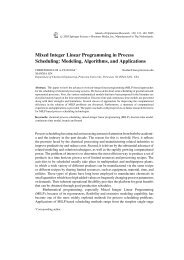Conceptual framework: What do you think is going on?
Conceptual framework: What do you think is going on?
Conceptual framework: What do you think is going on?
You also want an ePaper? Increase the reach of your titles
YUMPU automatically turns print PDFs into web optimized ePapers that Google loves.
03-Maxwell.qxd 10/1/2004 3:13 PM Page 56<br />
56 QUALITATIVE RESEARCH DESIGN<br />
Doing th<str<strong>on</strong>g>is</str<strong>on</strong>g> will often require <str<strong>on</strong>g>think</str<strong>on</strong>g>ing through the implicati<strong>on</strong>s of <str<strong>on</strong>g>you</str<strong>on</strong>g>r theory<br />
or understanding to see if these are c<strong>on</strong>s<str<strong>on</strong>g>is</str<strong>on</strong>g>tent with others’ findings. Th<str<strong>on</strong>g>is</str<strong>on</strong>g> <str<strong>on</strong>g>is</str<strong>on</strong>g> <strong>on</strong>e<br />
example of a “thought experiment,” which I d<str<strong>on</strong>g>is</str<strong>on</strong>g>cuss later in th<str<strong>on</strong>g>is</str<strong>on</strong>g> chapter.<br />
Finally, prior research can help <str<strong>on</strong>g>you</str<strong>on</strong>g> generate theory. Bernd Heinrich, while<br />
c<strong>on</strong>ducting h<str<strong>on</strong>g>is</str<strong>on</strong>g> thes<str<strong>on</strong>g>is</str<strong>on</strong>g> research <strong>on</strong> thermoregulati<strong>on</strong> in sphinx moths (1984,<br />
pp. 55–68), d<str<strong>on</strong>g>is</str<strong>on</strong>g>covered that h<str<strong>on</strong>g>is</str<strong>on</strong>g> experimental finding that these moths maintain<br />
a c<strong>on</strong>stant body temperature while flying was directly c<strong>on</strong>tradicted by others’<br />
research. He described h<str<strong>on</strong>g>is</str<strong>on</strong>g> resp<strong>on</strong>se as follows:<br />
As a first step in my dec<str<strong>on</strong>g>is</str<strong>on</strong>g>i<strong>on</strong> to proceed, I spent a few m<strong>on</strong>ths in the library reading<br />
about insect physiology in general and everything about sphinx moths in particular.<br />
Something in the known physiology and morphology might provide a<br />
clue. It would be necessary to collect more and more details <strong>on</strong> the problem until<br />
I could v<str<strong>on</strong>g>is</str<strong>on</strong>g>ualize it as closely as if it were a rock sitting in the palm of my hand.<br />
I wanted to find out how the moths were thermoregulating. ...<br />
I came across an obscure French paper of 1919 by Franz Brocher <strong>on</strong> the<br />
anatomy of the blood circulatory system in sphinx moths. The odd thing about<br />
these moths <str<strong>on</strong>g>is</str<strong>on</strong>g> that the aorta makes a loop through their thoracic muscles. In many<br />
or most other insects, it passes underneath these muscles. ...(Heinrich, 1984,<br />
pp. 63–64)<br />
Th<str<strong>on</strong>g>is</str<strong>on</strong>g> paper gave Heinrich the critical clue to how these moths were regulating<br />
their body temperature: They were shunting blood through the thoracic<br />
muscles (which move the moths’ wings) to cool these muscles, which would<br />
otherw<str<strong>on</strong>g>is</str<strong>on</strong>g>e overheat, and then losing the excess heat from the ab<str<strong>on</strong>g>do</str<strong>on</strong>g>men, in the<br />
same way that a car’s water pump and radiator cool the engine. Th<str<strong>on</strong>g>is</str<strong>on</strong>g> theory<br />
was c<strong>on</strong>firmed by subsequent experiments.<br />
It <str<strong>on</strong>g>is</str<strong>on</strong>g> possible, of course, to become too immersed in the literature; as<br />
C. Wright Mills warned, “<str<strong>on</strong>g>you</str<strong>on</strong>g> may drown in it ...Perhaps the point <str<strong>on</strong>g>is</str<strong>on</strong>g> to know<br />
when <str<strong>on</strong>g>you</str<strong>on</strong>g> ought to read, and when <str<strong>on</strong>g>you</str<strong>on</strong>g> ought not to” (1959, p. 214). One of<br />
Mills’s main ways of dealing with th<str<strong>on</strong>g>is</str<strong>on</strong>g> problem was, in reading, to always be<br />
<str<strong>on</strong>g>think</str<strong>on</strong>g>ing of empirical studies that could test the ideas he gained from the literature,<br />
both as preparati<strong>on</strong> for actual research and as an exerc<str<strong>on</strong>g>is</str<strong>on</strong>g>e of the imaginati<strong>on</strong><br />
(1959, p. 205). These two strategies c<strong>on</strong>nect to the final two sources for<br />
<str<strong>on</strong>g>you</str<strong>on</strong>g>r c<strong>on</strong>ceptual <str<strong>on</strong>g>framework</str<strong>on</strong>g>: pilot studies and thought experiments.<br />
PILOT AND EXPLORATORY STUDIES<br />
Pilot studies serve some of the same functi<strong>on</strong>s as prior research, but they<br />
can be focused more prec<str<strong>on</strong>g>is</str<strong>on</strong>g>ely <strong>on</strong> <str<strong>on</strong>g>you</str<strong>on</strong>g>r own c<strong>on</strong>cerns and theories. You can<br />
design pilot studies specifically to test <str<strong>on</strong>g>you</str<strong>on</strong>g>r ideas or methods and explore their
















